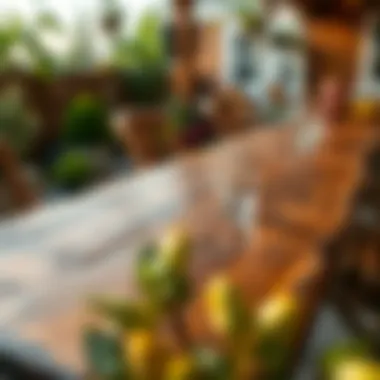The Appeal of Farmhouse Outdoor Dining Tables


Intro
In an era where outdoor living has become more cherished than ever, farmhouse outdoor dining tables stand out as a remarkable blend of style and functionality. These tables evoke a sense of warmth and community, reflecting traditions that have been passed down through generations. With their rustic charm, they are not just furniture; they tell a story of gatherings, shared meals, and cherished memories.
The desire to create inviting outdoor spaces has led homeowners and design enthusiasts to seek out furniture that complements their lifestyles while enhancing their gardens or patios. The allure of farmhouse styles combines simplicity with elegance, making these dining tables a focal point for al fresco dining experiences. Whether it’s an intimate dinner for two or a lively feast with family and friends, these tables bring a unique aesthetic that enhances any event.
With an abundance of designs, materials, and features available, understanding what makes farmhouse dining tables special can significantly shape outdoor living spaces. Let’s delve deeper into the design inspirations that drive this trend forward.
Understanding the Farmhouse Aesthetic
In the realm of design, the term "farmhouse" evokes images of cozy gatherings and rustic charm. This aesthetic goes beyond mere visuals; it embodies a lifestyle that values simplicity, craftsmanship, and a strong connection to nature. Embracing farmhouse elements in outdoor dining tables not only enhances the aesthetic appeal but also fosters a warm, inviting atmosphere for al fresco dining experiences. Homeowners and designers alike find charm in such tables, which act as a centerpiece for family meals or entertaining guests.
Defining Farmhouse Style
Farmhouse style is often characterized by its unpretentious simplicity and practicality. It's an aesthetic that combines functionality with warm, inviting design. Key features include:
- Natural Materials: The heavy use of wood, particularly reclaimed or distressed varieties, provides a rustic finish that connects the piece with its surroundings.
- Comfort: This style typically favors comfort over grandeur. Tables are often larger to accommodate family-style dining, reinforcing the idea of togetherness.
- Timelessness: Though farmhouse design has roots in historical styles, its appeal remains evergreen, making it suitable for various outdoor settings.
Understanding these aspects is essential for creating spaces that are not just visually appealing but also uniquely personal. For designers, it’s about channeling the right combination of elements to reflect the homeowners' values while fostering a sense of community and relaxation.
Historical Context
The farmhouse aesthetic traces its roots back to a time when functionality was paramount. Originating in rural America, it embodies a reflection of agrarian life where every piece of furniture served a purpose, often crafted by hand with care and thought. Over the decades, as urbanization took hold, the appeal of farmhouse style grew – a reminder of simpler times filled with harmony and connection to nature.
The aesthetic has evolved, influenced by various movements, from Shaker designs emphasizing minimalism to the Arts and Crafts movement highlighting craftsmanship. Today, this rich historical legacy lends depth and authenticity to modern farmhouse outdoor dining tables.
Embracing this historical context means acknowledging the craftsmanship behind each piece, the stories they tell, and the lasting impact they have on how we experience outdoor dining. In an ever-busy world, these tables serve as a reminder to slow down, enjoy good food, and connect with those around us.
— Design Enthusiast
By blending rich historical significance with practical functionality, the farmhouse aesthetic continues to captivate homeowners, making it a timeless choice for outdoor dining.
Key Characteristics of Farmhouse Outdoor Dining Tables
Farmhouse outdoor dining tables are more than just a piece of furniture; they're a statement of lifestyle, comfort, and connection to the outdoors. Understanding the standout characteristics of these tables is essential for homeowners and design enthusiasts looking to create inviting and functional outdoor spaces. When we delve into their key characteristics, we begin seeing how they embody a certain rustic charm while also ensuring practicality in various outdoor settings.
Material Variations
Wood Types
A significant aspect of farm house tables is the wood used in their construction. Options like reclaimed oak, pine, or teak are common choices. Reclaimed wood often wins hearts for its unique grain patterns and environmental sense, as it gives new life to old materials. Pine, on the other hand, is readily available and typically more affordable, offering a lighter tone that can brighten an outdoor space. Each wood type carries its own advantages, such as durability and aesthetics, but also considerations like maintenance needs. For instance, while teak is naturally resistant to weather elements, it does come with a higher price tag. Balancing aesthetics, budget, and durability is key to choosing the right wood.
Metal Elements
Incorporating metal into furniture design adds another layer of versatility. Steel bases can be both sturdy and stylish, allowing for varied table shapes and sizes. Aluminum is often favored due to its lightweight nature and weather resistance. Another advantage of metal accents is the way they can blend seamlessly with different wood types, enhancing the overall design. However, it's essential to consider that not all metals are rust-proof. Stainless steel is a great option, but other metals may require additional treatment to withstand outdoor conditions. Finding the right balance between metal’s industrial vibe and the warmth of wood helps create a cohesive look in outdoor environments.
Sustainable Options
With growing awareness around environmental impact, there's a shift toward sustainable materials in outdoor furniture. Eco-friendly choices include responsibly sourced woods or tables made from recycled materials. This kind of furniture not only benefits the environment but also often features unique design aspects due to the nature of the materials. For example, tables made from recycled plastic offer longevity and color uniformity without the heavy maintenance of traditional wood options. It's a win-win for those looking to minimize their carbon footprint while still achieving that quintessential farmhouse aesthetic.
Design Highlights
Table Shape
The shape of the table plays a crucial role in the overall functionality of your outdoor dining space. Rectangular tables are popular for their ability to fit multiple diners comfortably and can serve as a central gathering point. Round tables, however, create a more intimate setting, promoting conversation among guests. All shapes have their pros and cons, depending on the size of your outdoor area. A long, narrow table may fit well on a patio, while a round shape could work wonders under a sprawling tree in a spacious garden. The decision hinges on your social style and the ambience you wish to create.
Finishing Techniques
Finishing is where tables truly come to life. Whether it’s rustic, distressed, or a sleek polished look, the finish can enhance the wood’s natural beauty or provide protection against the elements. For instance, a distressed finish might be perfect for that aged, farmhouse feel, while a glossy finish reflects light, potentially opening up a smaller space visually. Moreover, appropriate finishing techniques can safeguard surfaces from scratches and spills, ensuring longevity for a life spent outdoors.
Color Palettes


Finally, let’s talk color. Farmhouse style tends to embrace natural tones, but it doesn't shy away from the bold if done right. Colors like sage green or slate blue can bring a fresh twist to traditional tones. By selecting colors that complement surrounding flora or outdoor decor, tables can blend beautifully into the landscape. Yet, one must also consider that brighter hues might require more maintenance. It’s always about striking a balance between personal taste and the feel you want to cultivate in your outdoor space.
Choosing the right elements, from material to color, can turn any outdoor area into a haven where memories are made and cherished.
Functional Aspects of Outdoor Dining Tables
When it comes to farmhouse outdoor dining tables, there’s more than meets the eye. Functionality plays a pivotal role in ensuring that these tables serve their purpose effectively while maintaining the rustic charm characteristic of the farmhouse style. Understanding the functional aspects, like size considerations and weather resistance, can significantly enhance the outdoor dining experience.
Size Considerations
Seating Capacity
One of the most crucial elements is the seating capacity. This directly influences how many guests can join for a meal, making it essential for family gatherings or dinner parties. A table designed to accommodate six to eight people not only fosters intimacy but also reflects the spirit of communal feasting often celebrated in farmland locales. A common choice is a rectangular table, which tends to maximize seating. However, round tables can promote more interaction among diners.
The unique feature of seating capacity is its adaptability; for example, many tables come with extension leaves, allowing for flexibility without needing to splurge on a new set. The drawback of having a table that’s simply too large is that it can overwhelm smaller outdoor spaces, creating a disjointed look. Therefore, choosing the right size based on available space and desired occupancy is paramount.
Space Planning
Equally important is space planning, which entails not just the table’s size but also how its arrangement fits within the designated outdoor area. Proper space planning can make or break the overall aesthetic and functionality of the dining experience. It helps homeowners visualize how the dining table complements other furniture, like outdoor lounges or fire pits.
A well-planned setup can create a seamless flow between indoor and outdoor spaces. This is why many opt for modular arrangements, allowing for easy rearrangement depending on the season or the occasion. Still, cluttering a small patio with oversized tables and chairs can lead to an uncomfortable dining experience.
Weather Resistance
Durable Materials
Durability is a make-or-break factor, especially in outdoor settings where tables confront the elements day in and day out. Common materials for farmhouse tables include cedar, redwood, and even teak, all known for their natural resistance to rot and decay. A significant advantage of durable materials is their longevity—many can last decades with proper care.
However, the downside may arise when considering the initial cost, as top-quality woods typically come at a premium. Yet, investing in durable materials not only enhances the lifespan but retains aesthetic value over time, making it a practical choice.
Protective Finishes
Protective finishes play a critical role in the preservation of outdoor tables. These coatings protect wood from UV rays, moisture, and temperature fluctuations, which can wreak havoc on unprotected surfaces. A varnish, sealant, or oil-based finish adds an extra layer of protection, making sure the charm of the table remains intact.
A unique feature of protective finishes is the ability to enhance the wood grain, giving the table a polished look while ensuring durability. On the flip side, maintenance is essential; periodic reapplication is necessary to keep the protective finish effective, and neglecting this can lead to costly repairs.
"Functionality and aesthetic beauty are not mutually exclusive in farmhouse outdoor dining tables. Instead, they are intricately linked, making each meal an experience worth savoring."
In summary, understanding the functional aspects of outdoor dining tables—the interplay of size, space planning, and weather resistance—can significantly elevate the outdoor dining experience. Homeowners and designers should keep these aspects in mind when selecting the right farmhouse dining table, ensuring that it not only meets practical needs but also complements the overall aesthetic of the outdoor area.
Styling Your Outdoor Dining Area
Styling your outdoor dining area is a pivotal aspect of creating an inviting and functional space that embodies the farmhouse charm. This isn’t just about aesthetics; it’s about weaving practical elements together with design to craft a cohesive outdoor experience. The right style enhances the ambiance, making outdoor meals feel special and not just a mundane extension of indoor dining. When done thoughtfully, it fosters an atmosphere where friends and family can gather and enjoy meals together under the open sky.
Complementary Furniture
Choosing the right furniture to accompany your farmhouse outdoor dining table is essential. By incorporating Chairs and Benches, you not only enhance comfort but also add to the overall aesthetic appeal of your space.
Chairs and Benches
When it comes to choosing chairs and benches, durability needs to be as important as design. Wooden benches or rustic metal chairs often complement farmhouse tables perfectly. This furniture choice blends seamlessly with the traditional style of farmhouse tables, creating a homely feel.
A standout aspect of these pieces is their versatility. They can easily transform from a casual family meal to a more formal dining experience based on the style of table setting you choose. With cushioned options available, comfort is increased—an essential factor if you tend to linger after dinner. However, one potential drawback of certain types of chairs is their susceptibility to wear in unpredictable weather conditions.
Decorative Accents
Decorative accents weave a narrative into your outdoor dining area, turning a simple setup into a charming sanctuary. Think seasonal flowers, woven baskets, or handcrafted centerpieces that evoke a rustic feel. A key characteristic of these accents is their ability to inject personality into the space. Items like colorful ceramic dishes or patterned table runners can elevate your space without a hefty cost.
A unique feature of decorative accents is that they provide a way to express your personal style. However, one should be mindful of clutter; too many accents can distract from the overall aesthetic. Selecting a few key pieces can often create a more striking impact.
Setting the Scene
The magic often lies in how you set the scene for your outdoor dining experience. The choice of Table Settings plays a crucial role in ensuring guests feel welcomed and engaged.
Table Settings
Bringing together table settings is more than just laying down cutlery; it’s about crafting an inviting atmosphere. Using cloth napkins, vibrant dishes, and beautiful glassware can enhance the charm of your farmhouse table. A key characteristic is that it allows for creativity—different seasons can inspire unique looks; for example, colorful tableware during summer or earthy tones in fall creates warmth.


However, there’s a catch—maintaining cohesiveness can be a challenge. If not coordinated, mismatched items can create visual chaos rather than harmony. Striking a balance between variety and coherence should be the goal for a refined dining experience.
Lighting Options
Finally, consider the role of lighting options in your outdoor dining area. Choosing the right lighting can transform the space from day to night effortlessly. String lights, lanterns, or even wall-mounted fixtures create a cozy glow that invites more extended conversations and joyful gatherings under the stars.
A significant advantage of using layered lighting is that it allows for versatility in mood—soft lighting can create a romantic dinner feel, while brighter lights are perfect for evening barbecues with friends. Nevertheless, one must consider the placement and intensity to keep the space from feeling overly stark or too dimmed.
"A well-styled outdoor dining area is not just a place to eat but a space where memories are made."
Ultimately, styling your outdoor dining area is about finding the right mix that speaks to your tastes and complements the farmhouse aesthetic. A little thought and careful selections not only beautify the area but also create a welcoming space that draws people in.
Maintenance of Farmhouse Outdoor Dining Tables
Taking care of farmhouse outdoor dining tables is essential for preserving their charm and utility. Regular maintenance ensures that these pieces remain not only beautiful but also functional throughout the years. Consider the weather and wear they endure; proper care can mitigate issues stemming from exposure to sun, rain, and the elements.
Cleaning Techniques
Routine Care
Routine care is all about consistency. A simple wipe-down with a soft cloth and mild soap can keep dirt and grime at bay. This not only helps maintain the aesthetics of the table but also prolongs its lifespan. The key to successful routine care is developing a habit—treating your table to this quick clean every couple of weeks, especially during high-use months, can prevent buildup that can lead to more significant issues.
Implementing this practice offers several advantages: it’s quick, cost-effective, and keeps your table looking its best. However, it’s worth noting that for materials like untreated wood, this might sometimes require more cautious handling to avoid damaging natural finishes.
Deep Cleaning
Deep cleaning goes a step further and should be conducted seasonally or whenever you notice the table looking a tad worn. This involves scrubbing surfaces, using proper wood cleaners, and sometimes refinishing those areas that need a little extra TLC. Deep cleaning allows for the removal of stubborn stains and dirt that routine care might miss.
The distinctive aspect of deep cleaning is that it not only refreshes but can also reveal any damage that might need addressing. While it’s undeniably effective, it requires a bit more elbow grease and some specific products that might add to the cost.
Preventative Measures
Seasonal Protection
When the seasons change, so too do the threats to your dining table. Seasonal protection involves using covers or treatments that shield your furniture from extreme weather—think sunshine, snow, rain, or the falling leaves of autumn. Investing in a good-quality cover kept on during inclement weather can significantly prolong your table's life.
This proactive approach is favored by many who own outdoor furniture. The unique feature of seasonal protection is that it allows you to enjoy your table without worrying about deterioration when conditions go awry. However, it does require a commitment to putting covers on and taking them off.
Repairing Damage
Despite best efforts, damage can occur. Repairing damage includes fixing scratches, dents, or discoloration that may have cropped up over time. Effective repair not only salvages your investment but also contributes to the overall beauty of your outdoor space. A first-aid kit for furniture—including Sandpaper, wood fillers, and paint—can come in handy.
Figures show that homeowners who attend to minor damages promptly can save themselves the headache of bigger repair jobs later on. However, improper repairs can lead to further issues if not done correctly, so considering professional help might be wise for more serious damages.
In summary, the maintenance of farmhouse outdoor dining tables is a blend of regular cleaning, deep cleaning, and proactive measures.
By committing to these tasks, your tables can continue to invite gatherings and dinners under the stars, serving as the heart of your outdoor entertaining space for many seasons to come.
Integrating Farmhouse Tables into Different Environments
Understanding how to integrate farmhouse tables into various settings adds a layer of depth to any outdoor dining space. This versatility makes them an attractive option, whether you're living in a bustling urban environment, amid serene rural landscapes, or alongside picturesque coastal areas. Each of these environments presents its unique challenges and benefits that can affect how a farmhouse table complements the surroundings.
Urban Settings
In urban environments, space is often at a premium. Often, a picturesque farmhouse table can transform a small balcony or patio into a warm gathering place. The rustic appeal of wood can stand out against the sleek materials typically found in urban architecture. Consider incorporating a round farmhouse table to encourage a more intimate setting, promoting conversations and shared meals — a cozy gathering spot amidst the hustle and bustle of city life. Choosing colors that contrast the urban palette can also breathe life into a confined space.
A few design tips for urban settings include:
- Selecting collapsible or extendable tables for flexibility.
- Adding potted plants or hanging herbs around the table for a touch of greenery.
- Using warm lighting options to create an inviting atmosphere during nighttime.
Rural Landscapes


In rural landscapes, farmhouse tables shine, echoing the natural surroundings. They can blend effortlessly with the environment, serving as a reminder of simpler times. The setting often allows for larger, sturdier tables that can accommodate family gatherings on sunny afternoons. Imagine a long rectangualr table, surrounded by a wide-open space with views of fields or forests, enhancing the rural experience.
Key considerations for rural settings:
- Emphasizing natural materials that complement the outdoor surroundings.
- Incorporating larger tables to make room for family-style meals, especially during gatherings.
- Opting for weathered finishes that resonate with a country aesthetic, further blending with nature.
Coastal Areas
When it comes to setting up a farmhouse table in coastal environments, durability is key. The salty air and potential moisture can take a toll on wooden furniture, so it’s important to choose materials that withstand these elements. A table made from reclaimed teak or cedar can endure season after season. In coastal areas, the vibe is often casual and inviting, making a farmhouse table fit naturally within a beachside setting.
To enhance the atmosphere in coastal areas:
- Focus on lighter hues that mirror the sand and sea.
- Include seating options that provide comfort while maintaining an easy-going vibe.
- Utilize nautical-themed decor or table settings to tie the spaces together, creating a coherent visual experience.
Integrating farmhouse tables into different settings enhances not only the aesthetic but also the functionality of outdoor spaces, allowing homeowners to make the most of their environment.
Overall, the adaptability of farmhouse tables ensures they can serve as both a functional centerpiece and a statement piece, whatever the setting. Whether in a city high-rise, sprawling fields, or beachfront, a farmhouse table can be woven seamlessly into the fabric of any lifestyle.
Trends in Farmhouse Outdoor Dining Tables
The landscape of outdoor dining has evolved significantly, and farmhouse-style tables are at the forefront of this transformation. These pieces aren’t just about utility; they embody a sense of nostalgia and warmth, making outdoor spaces more inviting. The trend towards farmhouse outdoor dining tables reflects broader lifestyle shifts, where homeowners prioritize connection—whether that’s with family, friends, or nature itself.
In contemporary design, there’s an undeniable gravitation towards sustainability and craftsmanship. The rustic charm of farmhouse tables paired with modern manufacturing methods has redefined what these tables can be. As people become more environmentally conscious, the demand for sustainable designs has risen, breathing new life into traditional aesthetics.
Current Market Insights
The current market for farmhouse outdoor dining tables shows a fascinating blend of traditional craftsmanship and modern demands. With a surge in home renovations, consumers are willing to invest in quality outdoor furniture that complements their lifestyle. Unlike mass-produced alternatives, many farmers market tables feature hand-selected wood, often from reclaimed sources. This practice not only reduces environmental impact but also provides unique character to each piece.
Some notable trends detected in the marketplace include:
- Emphasis on Customization: Many shops now offer customizable options, allowing customers to select dimensions, finishes, and designs that resonate with their personal style.
- Mixed Materials: While wood remains a favorite, there’s an emerging trend towards integrating metal and glass elements, providing a contemporary twist on classic designs.
- Economical Choices: On the budget side, people are also gravitating towards affordably crafted replicas that still echo the farmhouse charm without breaking the bank.
Market insights suggest that buyers are increasingly favoring brands that embed sustainability in their value proposition. For individuals looking for similar pieces, platforms like Etsy and Wayfair have become popular.
Sustainable Practices
As sustainability takes center stage, the farmhouse outdoor dining table industry has embraced eco-friendly practices. Homeowners are more conscious about where their furniture comes from and how it’s made, leading to a growing demand for tables constructed using ethically sourced materials. Not only does this practice ensure durability, but it also aligns with a greater societal shift towards minimizing ecological footprints.
Some sustainable practices being adopted include:
- Utilizing Reclaimed Wood: This type of wood not only reduces waste but often introduces a distinct patina that new materials lack.
- Eco-Friendly Finishes: Tables are now often treated with non-toxic varnishes or oils that help protect against the elements while keeping a safe environment for families, especially those with children.
- Local Sourcing: Many artisans emphasize locally sourced materials to cut down shipping emissions, contributing to a lower carbon footprint.
By aligning traditional aesthetics with modern sustainability principles, the trend culminates in a farming of design that respects both the past and the future. As homeowners incorporate these practices, they not only enhance their outdoor spaces but take an active role in promoting responsible consumerism.
“Investing in a farmhouse table isn't just about owning furniture; it's about advocating for sustainability while embracing timeless craft.”
The Future of Outdoor Dining Furniture
As we look ahead to the evolution of outdoor dining furniture, particularly farmhouse tables, there’s a palpable excitement in the air. The allure of these tables isn't simply tied to their rustic charm; it embodies a shift towards sustainable, innovative designs that resonate with many homeowners and designers alike. With escalating concerns around environmental impact and a desire for unique expressions of style, the future beckons with both opportunities and challenges for outdoor dining furniture.
Innovative Designs
Innovative designs breathe new life into farmhouse outdoor dining tables, melding traditional aesthetics with modern sensibilities. More than just being functional, these pieces are now often seen as the statement piece of an outdoor experience.
- Multifunctionality: Today's designs often embrace flexibility. Tables that expand for larger gatherings or those that integrate seating into their structure accumulate a growing following. For instance, a table that can shift from a cozy dining setting to an outdoor buffet ensures it meets diverse needs effortlessly.
- Mix of Styles: This new era often sees a blend of different styles. Vintage wood combined with metal accents or bright colors offers a fresh take on traditional looks, bridging the gap between rustic charm and modern vibrancy.
- Shapes and Configurations: Round tables are gaining traction, breaking away from the classic rectangular shapes that have long dominated. They encourage more intimate interactions among guests while remaining a striking centerpiece in outdoor coucepts.
This innovative spirit reflects consumers' desire to adapt their space to their lifestyle, creating an outdoor dining experience that is both personal and memorable.
Technological Integration
The future of farmhouse outdoor dining tables is not merely confined to aesthetics or materials; it also extends into the realm of technology. As homeowners become increasingly tech-savvy, there’s a rising trend for furniture that incorporates smart features.
- Smart Materials: Imagine tables that can sense the weather, adapting their surfaces to prevent water damage or sun exposure. Treatments that react to moisture or UV levels could prolong the life of the table while maintaining its aesthetic.
- Built-in Charging Stations: The inclusion of USB ports or wireless charging pads on tables allows for seamless connectivity over meals. Guests can share experiences or catch up on messages while enjoying their time outdoors.
- Smart Lighting: Outfitting tables with LED lighting that adjusts based on time and ambiance elevates outdoor dining past just function. When dusk falls, the right illumination transforms the atmosphere, providing a beautiful backdrop for gatherings.
Furthermore, these technological advancements not only enhance user experience but also open avenues for eco-friendly solutions, such as solar-powered lights or tables made from recycled materials.
"The elegant simplicity of farmhouse outdoor tables is being redefined, combining natural beauty with the functionalities of modern living."
In sum, as we step into the future, the integration of innovation and technology alongside a commitment to sustainability will shape the way farmhouse outdoor dining tables evolve. These developments not only reflect changing tastes but also allow homeowners to express their individuality while keeping with the collective aspiration of protecting our environment.



